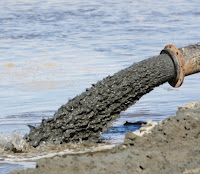 |
| Slurry pipeline. |
Long distance slurry pipelines for moving mineral concentrates over various elevations and long distances is often more economical than trucking or rail due to topography constraints and environmental concerns. To capitalize on these investments, the pipe sizes are maximized. Therefore, large-bore dependable valves are vital to the success of the slurry pipelines.
Three months after the main choke and choke loop press letdown stations were commissioned at a large copper-gold-molybdenum mining operation, ongoing repairs were required for all eight competitor valves. Valves in this position were expected to perform for at least 180 cycles without repair. These failures and leakage problems were caused by the valves’ integral seat design, which form a gap between the ball and seat allowing particles to enter the sealing area in the reverse pressure. This problem cost this customer an average of $800,000 to $1M per year in maintenance repairs.
Solution
 |
| After one year the MOGAS valve performed 818 successful cycles—over four times the cycle count required in this application. |
In January 2013, a 36-inch, ASME 300 Class model CST-1 valve was installed in the first loop of the control station. In this model’s proven bi-directional seat design, the seat maintains 100% contact with the ball in both normal and reverse pressures. This prevents build-up behind the downstream seat and ensures evacuation of solids around upstream seat during cycling.
Results
 |
| Under the same process conditions, the competitor’s valve underperformed and required frequent maintenance due to erosion. |
After three years of continuous operation, the MOGAS valve had successfully performed 1033 cycles. On inspection, the ball and seat were in good repair, so only the gasket and packing box were replaced and the valve was put back in to service.
Advantages to installing a MOGAS valve:
- No downtime due to increased cycle time and continuous operation
- No repair or maintenance of ball and seat
- Increased cycle count and greater revenue
For more information, contact CTi Controltech by calling 925-208-4250 or visit https://cti-ct.com.
Reprinted with permission from MOGAS.